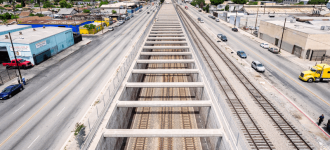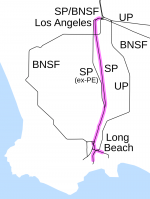PeterFromLA
Active Member
- Joined
- May 15, 2019
- Messages
- 289
- Location
- Los Angeles
- Aircraft
- American Ranger AR-1, Kallithea
- Total Flight Time
- 1,100+
This is an easy flight, that I often do to visit with friends at Torrance...

Hello Peter,
I agree with Resasi, very well done.
I do have to ask, why did you choose the route in the video as opposed to flying over LAX using the Los Angeles Special Flight Rules Area? The latter is a more direct route.
The next question. While flying over the city and below the Class B airspace, were you monitoring and providing position reports on 123.025 when North of the 91 Fwy and 122.850 when South of the 91 Fwy respectively? Below 2000 MSL there is a good volume of freeway traffic reporting, TV, police, military rotor craft, and VFR fixed wing aircraft flying around in that same airspace. It is very good practice.
I'm sure you are familiar with the Southern California Airspace Users Working Group (SCAUWG). A very long time and good friend of mine, Ron Berinstein CFII and FAASTeam Representative is the creator and administrator of the website.

- Southern California Airspace Users Working Group
The Southern California Airspace Users Working Group is dedicated to making LA Airspace the safest possible. It is a committee of professionals from all segments of the Southern California aviation industry determined to resolve airspace-related problems and improve safety, utility, and...scauwg.org
Keep up with the videos. My fixed-wing friends enjoy watching.
Wayne
Transition routs are full of fast planes that aren’t looking for gyroplanes.Hello Peter,
I agree with Resasi, very well done.
I do have to ask, why did you choose the route in the video as opposed to flying over LAX using the Los Angeles Special Flight Rules Area? The latter is a more direct route.
Wayne



Wow that corridor is impressive, some of the infrastructure you guys have over there is simply mind blowingHello Peter,
KBUR is very accommodating with transitions through their airspace. I've never had a problem. A great group of controllers.
For the past 25+ years, Compton Airport (KCPM) has been a haven of flight training for students from Asia. Radio communications has been a problem because of the lack of fluency in the English language. It is good to listen to the CTAF, however since many of the students are not fluent in English, they often forgo traffic reporting because the airfield is uncontrolled.
AirNav: KCPM - Compton/Woodley Airport
Complete aeronautical information about Compton/Woodley Airport (Compton, CA, USA), including location, runways, taxiways, navaids, radio frequencies, FBO information, fuel prices, sunrise and sunset times, aerial photo, airport diagram.www.airnav.com
Yes, flying along the Alameda Corridor, it is very common for foreign registered commercial airliners to "bust through the bottom" of Class B airspace when turning final for either 24L & 24R at KLAX. Before the days of ADS-B, I have had on two occasions foreign registered B-747s overtake me less than 500 ft above as they busted through the floor of the Class B.
For those who may not know, the Alamedia Corridor is a very visible 20+ mile, north-south, triple track, main line freight rail right-of-way trench owned by the Alameda Corridor Transportation Authority. Both the Union Pacific and Burlington Northern Santa Fe railroads have trackage rights. The Alameda name comes from the north-south Alameda Blvd that is adjacent of the right-of-way. The primary reason for this rail line is to haul shipping containers from Los Angeles and Long Beach Harbors to the UP and BNSF rail yards just outside of Downtown Los Angeles without tying up city streets with grade level railroad crossings. Prior to the installation of the corridor, the shipping container trains followed 100+ year old right-of-ways.
Wayne
View attachment 1152951
View attachment 1152950
View attachment 1152952
Yes, Burbank is a very easy Charly airspace to transition through - they have great experience with GA, and are very accommodating. In fact I am so spoiled talking to them, I get annoyed at some other Charlies that are not so accommodating...Hello Peter,
KBUR is very accommodating with transitions through their airspace. I've never had a problem. A great group of controllers.
For the past 25+ years, Compton Airport (KCPM) has been a haven of flight training for students from Asia. Radio communications has been a problem because of the lack of fluency in the English language. It is good to listen to the CTAF, however since many of the students are not fluent in English, they often forgo traffic reporting because the airfield is uncontrolled.
AirNav: KCPM - Compton/Woodley Airport
Complete aeronautical information about Compton/Woodley Airport (Compton, CA, USA), including location, runways, taxiways, navaids, radio frequencies, FBO information, fuel prices, sunrise and sunset times, aerial photo, airport diagram.www.airnav.com
Yes, flying along the Alameda Corridor, it is very common for foreign registered commercial airliners to "bust through the bottom" of Class B airspace when turning final for either 24L & 24R at KLAX. Before the days of ADS-B, I have had on two occasions foreign registered B-747s overtake me less than 500 ft above as they busted through the floor of the Class B.
For those who may not know, the Alamedia Corridor is a very visible 20+ mile, north-south, triple track, main line freight rail right-of-way trench owned by the Alameda Corridor Transportation Authority. Both the Union Pacific and Burlington Northern Santa Fe railroads have trackage rights. The Alameda name comes from the north-south Alameda Blvd that is adjacent of the right-of-way. The primary reason for this rail line is to haul shipping containers from Los Angeles and Long Beach Harbors to the UP and BNSF rail yards just outside of Downtown Los Angeles without tying up city streets with grade level railroad crossings. Prior to the installation of the corridor, the shipping container trains followed 100+ year old right-of-ways.
Wayne
View attachment 1152951
View attachment 1152950
View attachment 1152952
